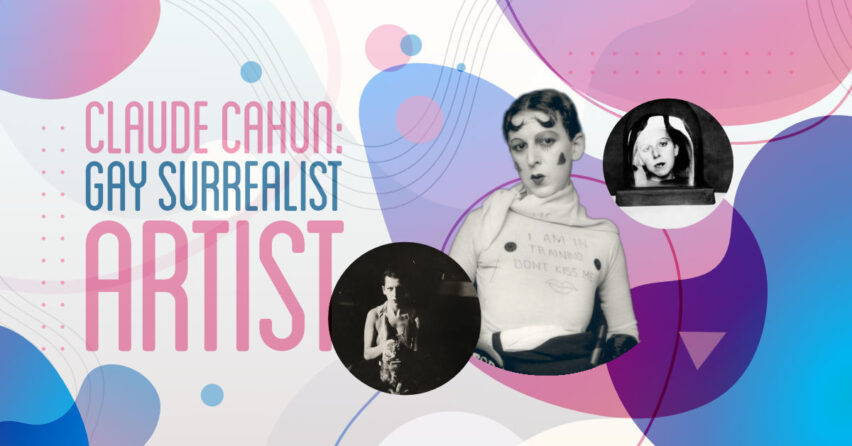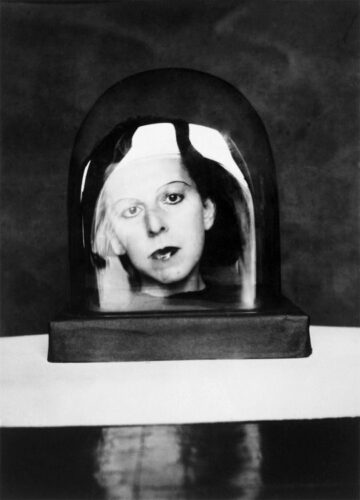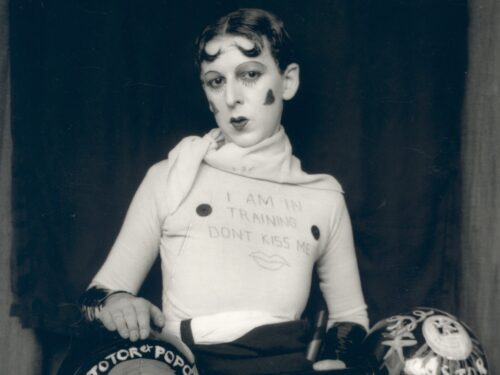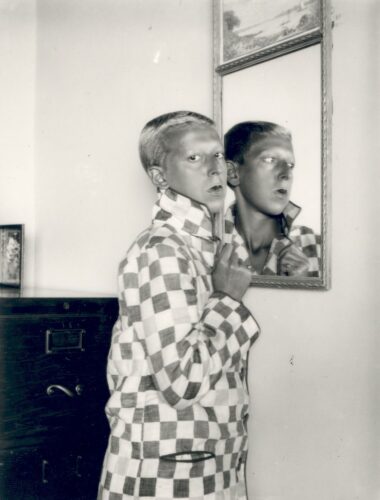Claude Cahun: Gay Surrealist Artist
by Siobhan Donegan
Claude Cahun is mostly known as a surreal artist, specifically for their self-portraits photographic work which have been described as presenting a ‘dizzying kaleidoscopic mix of mystery and exuberance’. Cahun is also known for their photo-montages, with whom their/her long-term partner Marcel Moore contributed to in the capacity of ‘artist collaborator’. Cahun’s iconic photography has also been described as a ‘dialogue with multiplicity’. In a creative psychological context, it was an ongoing self-exploration of their character/personality through text and imagery. Cahun described it themselves as a ‘hunt’ – presumably for self and identity.
As well as being a French Surrealist photographer artist, Cahun was a writer, sculptor and activist. They also were a propagandist and resistance worker during World War 2. Cahun was gay and if they were alive today may have identified as non-binary or perhaps more specifically genderfluid. As Cahun themselves stated ‘Masculine? Feminine, it depends on the situation. Neuter is the only gender that always suits me’. In this context Cahun’s photographic self-exploration didn’t just depict a number of theatrical personalities but also explored gender identity/expression.
Cahun has been described as having ‘protested gender and sexual norms’ with their name change and as such they have attracted an increasing following amongst feminists and people within the LGBT community, and on an intellectual level the interest of Art Historians. Cahun in fact, was multi-talented as they were also a Poet, Critic, translator and Essayist. However, it was through fully embracing their gender identity\fluidity that they are considered a ground-breaking Artist.
Claude Cahun’s original name was Lucy Renee Mathilde Schwob and was born on the 25th October 1894, and died on the 8th December 1954. Cahun was born into an intellectual Jewish family in Nantes. Their great uncle David Leon Cahun had been an orientalist, whilst their uncle Marcel Shwob was an Avant-garde writer. Their mother Mary Antoinette Courebaisse was taken into a psychiatric facility because of her mental illness. As a teenager, Cahun also struggled with mental illness, including ‘suicidal thoughts’, bulimia and ‘crippling sadness’.
Cahun’s early education included the Parson’s Mead School in Surrey which was a private school. This was after they had unfortunately experienced antisemitism at high school in Nantes. Cahun also studied at the University of Paris-Sorbonne. It was at the age of just 18 in 1912 that they made their first initial experimental photographic self-portraits. Their image making expression continued throughout the 1930s.
In about 1915 they had their hair cut very short and continued working on their photographic self- exploration at the same time. These photographs have been described as ‘cross-dressing experiments’ as they could be dressed as a ‘sportsman, sailor or dandy’.
Cahun adopted the pseudonym-Claude Cahun, as this was more gender neutral. They had previously used the names Claude Courlis after Curlew, and Daniel Douglas apparently taking inspiration from lord Alfred Douglas.
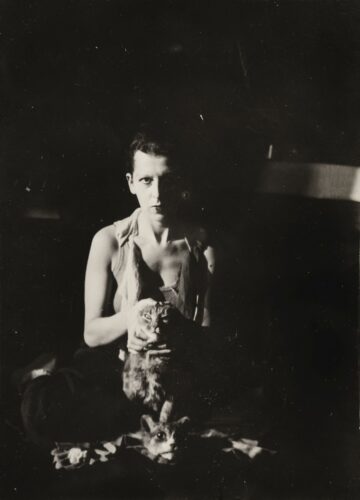 As previously mentioned Cahun creatively explored gender identity and the subconscious mind through surrealist photography. Their self-portraits featured outfits that defied conventional identification of feminine or masculine, and today would perhaps be described as gender neutral or fluid. Cahun in reference to their self-exploration famously stated, ‘Under this mask, another mask’ and ‘I will never be finished removing all these faces’. Taking this into consideration, Cahun’s work has generated interest beyond the history of photography, for example and significantly in Gender Studies.
As previously mentioned Cahun creatively explored gender identity and the subconscious mind through surrealist photography. Their self-portraits featured outfits that defied conventional identification of feminine or masculine, and today would perhaps be described as gender neutral or fluid. Cahun in reference to their self-exploration famously stated, ‘Under this mask, another mask’ and ‘I will never be finished removing all these faces’. Taking this into consideration, Cahun’s work has generated interest beyond the history of photography, for example and significantly in Gender Studies.
Suzanne Malherbe, who also changed her\their name to Marcel Moore, became Cahun’s lifelong partner after they both settled in Paris in the early 1920s. It was after Cahun had moved to Paris that they became involved with the Surrealist Parisian Art scene – it was then that Cahun went on to collaborate with the famous Man Ray. Cahun and Moore, as well as being partners also collaborated on many creative projects. These included photomontages, sculptures and written works. Surprisingly, Cahun and their partner also became ‘step-siblings’ as Cahun’s divorced father married Moore’s widowed mother.
Cahun and Moore, after relocating in Paris, slowly became involved in the small Parisian avant-garde circle, who coincidentally were also exploring aspects of identity. Probably one of the most famous artists at the time ‘playing’ with gender was Marcel Duchamp who introduced Rrose Selavy, his artistic character and female alter ego. Cahun and Moore in fact welcomed avant-garde artists and writers to the parties that they organised at their house in about 1922.
Cahun and their partner also met the head of experimental theatre ‘Le Plateau’- Pierre Albert Birot. Here, both again collaborated with Moore designing stage sets and costumes – Cahun concentrating on performance skills.
In this connection it is interesting to note that Cahun’s self-portraits incorporated elements of theatre and the aesthetics of surrealism. They also significantly ‘blurred’ gender indicators, partly through often showing only head and shoulders. In some pictures, Cahun’s head is shaved looking directly at the viewer; this together with the varying gender representations was apparently a way of undermining the ‘patriarchal gaze’.
As mentioned above, Cahun was also a writer and had some of their writings published. These included ‘Heroines’ in 1925 which featured a ‘series of monologues’ based on female fairy tale characters. These were ‘intertwined’ with images of modern contemporary women as a means of making witty comparisons.
Cahun became involved with the ‘Association des Ecrivains et Artistes Revolutionnaires’ in 1932. They took part in certain surrealist exhibitions which included the London International Surrealist Exhibition and in Paris (1936) ‘Exposition Surrealiste d’Objets.
Finally, I just wanted to add that as a Surrealist artist, Cahun has mostly been written out of art history until their photographic work was included in an exhibition in 1986. Only then, Claude Cahun was recognised as a significant artist and gained an increasing following.
